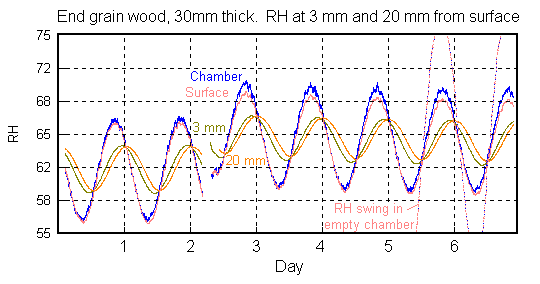
 |
Water vapour absorption in end grain wood tiles |

This diagram shows the behaviour of the same wood panel that took part in the competition described in chapter 3. Now, the wood has RH sensors buried beneath the surface in little cavities at about 3 mm and 20 mm below the surface. The constant flux of the previous experiments has been replaced by a sinusoidal variation which gives a better simulation of the daily variation in relative humidity. The diagram shows the RH in the experimental chamber, in blue, and the measured RH at the wood surface and within the wood.
The water vapour flux is varied with a daily cycle. The effect of this flux cycle on an impermeable room with no buffer capacity is shown by the wide RH swings at the right side of the diagram. The RH buffering by the wood is impressive, but it is much less than expected from calculations based on the published absorption curve and diffusion constant. The RH within the small cavities at different depths from the surface shows a very strange pattern. The RH at 20 mm hardly differs from the RH at 3 mm, but the response is delayed.
The only reasonable explanation for this behaviour is that the damaged outer surface absorbs quite strongly but the intact cell walls of the interior absorb water vapour very slowly. This allows the water vapour that struggles through the surface layer to diffuse deep into the wall.
The sudden break in the graph during day 3 was caused by injecting 20 g/m3 of water into the chamber. The RH cycle continues at a higher value but drifts slowly down as the wood absorbs water over a period of several days. This is further evidence for the slow response of wood.
The experiments described in this article were performed in an unusual climate chamber which controls the water vapour flux into the air. The normal climate chamber controls the relative humidity of the air. RH control is fine for examining how materials respond to a perpetual flow of air with enormous reserves of water vapour. Indoors the situation is not at all like that. The RH is a dependent variable, defined by the balance of water fluxes from people, cooking pots, air leakage, furnishings, walls, ceiling and floor.
In most modern interiors the surfaces facing the room are painted or varnished, so that the water generation by people and the exchange with the outside air causes rapid changes of relative humidity. This is not a good situation. It results in transient condensation, which allows mould to grow on the cooler surfaces. The air leaking out of the room is sometimes humid and may cause condensation at points within the wall that are exposed to the concentrated stream of air through the random array of cracks in the surface.
The investigation of these situations requires a climate chamber that can imitate the activities in a room and the limited availability of water vapour from the air. The chamber is described in a technical note

This work is licensed under a Creative Commons Attribution-Noncommercial-No Derivative Works 3.0 License.